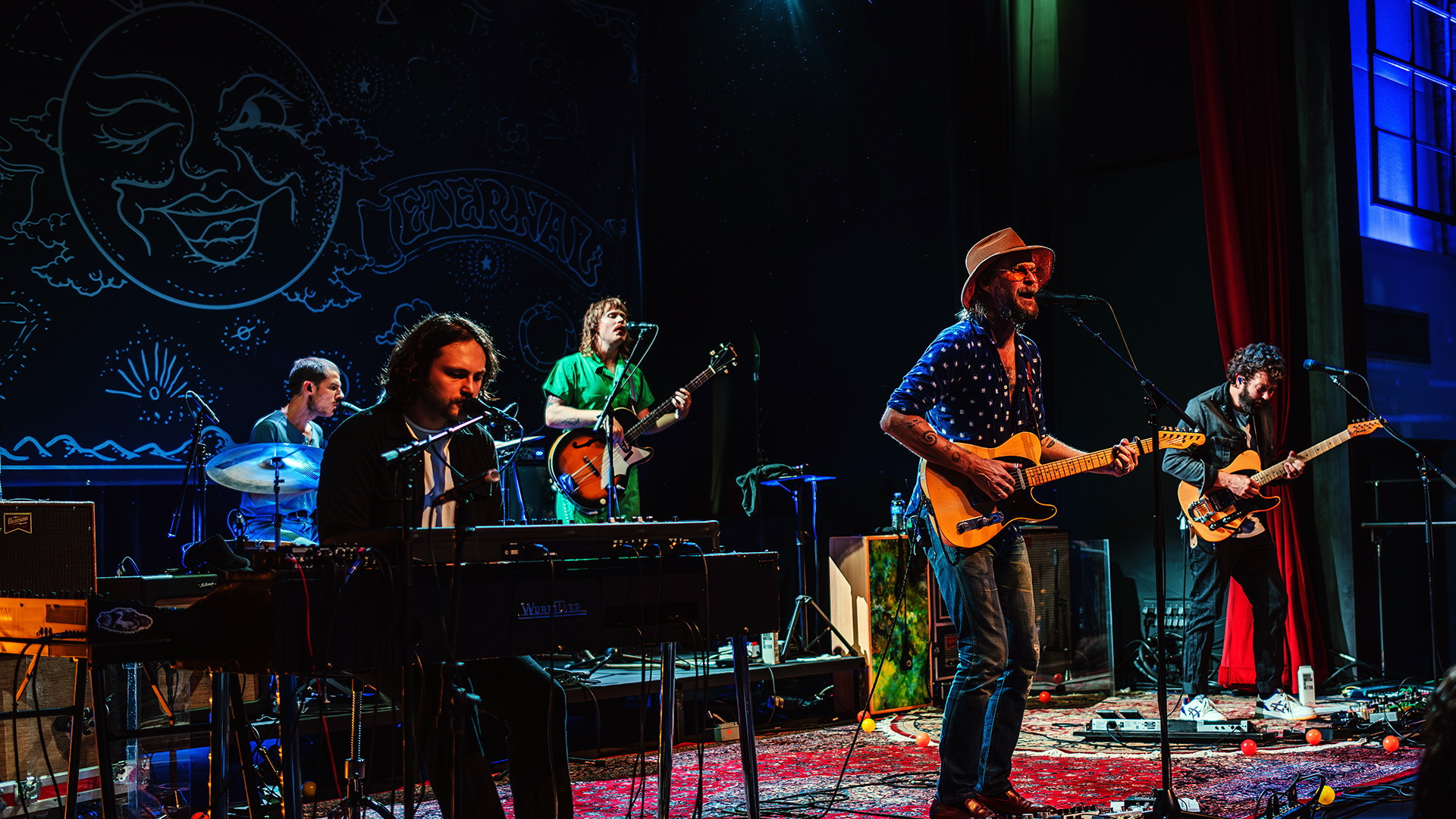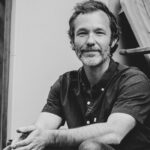
Blue Country Mystic
How Hiss Golden Messenger’s M.C. Taylor moved to North Carolina from California and found his voice in the South.
It’s just after 1 p.m. on a summer Sunday afternoon when M.C. Taylor approaches the microphone at Citizen Vinyl—a record manufacturing plant and recording studio in downtown Asheville, North Carolina—and greets the shoulder-to-shoulder crowd with a sarcastic grin.
“If I’d known this many people would show up, I would’ve charged,” the forty-eight-year-old musician, who performs and records as Hiss Golden Messenger, jokes while tuning a small-bodied Martin guitar. “It’s one of many bad decisions I’ve made in my career.”
Most of the 100-plus folks there to see him play songs from the new Hiss Golden Messenger album, Jump for Joy, would likely disagree with the self-deprecating comment. Because over the last fifteen years, Taylor has produced a body of work matched in quality or quantity by very few contemporaries in the loosely defined genre of Americana music.
Lanky and sparsely tattooed, Taylor is wearing a black tank top, faded Levi’s, amber-tinted glasses matching his grizzled beard, and a straw fedora—personifying the “rock ’n’ roll scarecrow” look referenced in one of his earlier songs. He intertwines colorful vignettes about the making of the aptly titled Jump for Joy, which was pressed in this building and released two days prior, with stripped-down renderings that bring focused attention to his lyrics.
Like the album’s leadoff track—an autobiographical reflection on Taylor’s nonlinear, faith-testing journey of making music that asks questions without seeking answers. In typical Hiss fashion, Taylor pays off its introspective verses with a jubilant, testifying chorus:
I’m waiting, trying to write my masterpiece
And it’s coming out a riddle
Got 20 years and a nickel
Guess I shoulda been smarter
It shouldn’t take much longer
Than 20 years and a nickel
—“20 Years and a Nickel”


Taylor grew up in Orange County, California, as a “typical beach and skateboard kid.” He started playing guitar in middle school and gradually nurtured an interest in music. His parents, both public school teachers, piqued his curiosity with their “limited but great” vinyl collection.
“I started to discover my own taste, which included what my parents listened to—The Byrds, Buffalo Springfield, Joni Mitchell, and Cream—but also stuff that was contemporary to me then,” he tells me. “I attribute my fascination with rhythm to the stuff I was listening to as an eleven- or twelve-year-old… the first couple Public Enemy records, EPMD, Stetsasonic, Gang Starr, early Run-D.M.C. I was fascinated with musical subcultures like early hip-hop and punk that felt so rich and deep but existed on the periphery of American over-culture.”
During his freshman year at UC-Santa Barbara, Taylor met Scott Hirsch and formed Ex-Ignota, a hardcore punk band with arty, experimental leanings. They cut a few records and toured hard, but Taylor grew restless. Feeling hemmed in by the sonic guardrails of the noise-rock scene, he became a self-described “musical omnivore” and plotted a change of course.
“I wanted more breadth of instrumentation and a deeper emotional palette,” he explains. “I was starting to discover music that felt really deep and broad and interesting… everything from early Tortoise records, The Sea and Cake and stuff on Thrill Jockey, to King Tubby and dub records, to stuff we now think of as Americana. Coming from the world I was in, starting to explore country music felt like the most confrontational thing I could be doing. So, in that way, it was an intentional move. When someone from the hardcore world would ask me what I was into and I’d say, ‘Roy Acuff and the Blue Sky Boys,’ that felt like a challenge.”
“When someone from the hardcore [punk] world would ask me what I was into and I’d say, ‘Roy Acuff and the Blue Sky Boys,’ that felt like a challenge.”
Taylor and Hirsch moved to San Francisco and founded The Court & Spark, cribbing the title of a 1974 Joni Mitchell album and leaning into the Laurel Canyon sound of that era. Dark horses of the early “alt-country” movement, The Court & Spark released four albums of cosmic, pastoral indie rock that drew critical acclaim and a loyal Bay Area following but ultimately fizzled in 2007.
“We were spinning our wheels and making lateral moves at best,” laments Taylor, who was the band’s principal singer and songwriter at a time when he says he’d not yet found his authentic voice. “Everybody had jobs and was getting older. Everybody had differing levels of dedication and skills, honestly. I had things I wanted to accomplish with music but was just not able to do so for a bunch of reasons. And I never made any money which, for the amount of time I’d put into it, made it feel like a gamble to keep going.”
See, is there life for me?
Is there a wife and a baby?
Because I’m going that way, anyway
Through the unfamiliar country
Southern grammar
Father and child
Let this be simple for a little while
—“Southern Grammar”


Frustrated and unmoored, Taylor moved across the country to pursue a graduate degree in folklore at the University of North Carolina at Chapel Hill. He and his wife, Abby, hit the road a few days after getting married, looking for a fresh start on the opposite coast.
“My wife, who’s from Maine, and I were looking for a reason to leave San Francisco,” he recalls. “So, the graduate degree was almost secondary. At the time, there were only a few folklore programs left in the country—UNC, Indiana, and Penn State. I’d been through North Carolina on various tours over the years and always thought it was a cool place but knew very little about it and didn’t know anybody here. We didn’t have kids and were more footloose in those days, so what seems hard now was a no-brainer then.”
Though he was conflicted about his future as a songwriter, Taylor hoped that by building a family and life in the South—and immersing himself in our cultural vernacular through his fieldwork as a folklorist—he’d gain fluency in the language he hoped to channel through his music. He admits to never feeling a true spiritual connection to his native California and thought such a drastic move would instill a sense of place that had until then eluded him.
“Things felt visible and palpable to me in ways they might not to someone that grew up here because I wanted to see and feel them,” he says.
Taylor spent nearly three years working for the state as a folklorist, driving to communities in eastern North Carolina to capture field recordings of people considered to be musical tradition-bearers.
“Part of me was hoping I’d move to the South—where so much of what I love was created—and that somehow, by osmosis, I’d be able to incorporate my lived experiences into music in a way that felt genuine.”
“I’d hang out with a banjo player in Warren County or an R&B singer in Scotland Neck,” he recalls. “I took photos, interviewed them, and recorded them playing, then processed the material to go into the state archives.”
The experience reintroduced Taylor to the sheer joy and communality of making music with no agenda. Musicians he documented were playing and singing for themselves, their families, and their communities as a form of conversation and connection, not to rehearse for a gig or recording session.
Time off the road and away from the thankless minutiae of fronting a band provided a meditative space to renegotiate his relationship with music.
“I was reorienting myself,” he says. “Part of me was thinking I was done making music in the public sphere, and part of me was hoping I’d move to the South—where so much of what I love was created—and that somehow, by osmosis, I’d be able to incorporate my lived experiences into music in a way that felt genuine.
“With Court & Spark, I tried to make music that didn’t feel like it was necessarily mine. And many people who have successfully made music with roots in the South have never lived in the South. I didn’t want to write fantasy.”
I’m not gonna dance until my ship comes in
but when my ship comes in
I’m gonna lose my mind
—“Call Him Daylight”


Taylor returned to his notebook and instruments, inspired not only by these characters he’d met, but also by Wendell Berry’s plainspoken poetry, biblical allegory and Appalachian gothic. In the dead of winter, he sat down with an acoustic guitar at his kitchen table in Pittsboro, North Carolina, and pressed record on a Sharp cassette player as his newborn son slept upstairs.
The new songs sounded timeless and vulnerable, cracked and yearning, thanks to the whispered, reedy warmth of Taylor’s vocals and dusty, lo-fi aesthetic. By unearthing an intimacy and emotional fullness simmering in his subconscious, likely coaxed by finding footing in the South, he gained confidence and motivation.
“It felt really close and personal because it was just me; I wasn’t depending on anyone else to carry the vibe,” he reflects. “Through this rediscovery, I realized I was making songs that felt very visceral…which is the most important thing about making music. It was a feeling I’d been wanting to find. And it’s something I have more or less kept intact since.”
He didn’t intend for anyone to hear the compositions, but at the encouragement of a few trusted friends decided to share them with the world. Bad Debt was released in 2010 under the name Hiss Golden Messenger.
“It wasn’t meant to be a record,” Taylor says. “It just became one.”
“I realized I was making songs that felt very visceral…which is the most important thing about making music. It was a feeling I’d been wanting to find. And it’s something I have more or less kept intact since.”
Bad Debt wasn’t actually the first Hiss Golden Messenger album. Country Hai East Cotton, which Taylor recorded before leaving San Francisco, came first. “But it feels more connected to Court & Spark in terms of the way I’m performing, singing, writing,” he says. “I think of Bad Debt as the first proper Hiss record because it has all the signature moves I still use.”
He decided early on that any post-Court & Spark project would carry a pseudonym.
“I needed something more interesting than M.C. Taylor,” he explains. “And I needed some words to hide behind.”
When asked to articulate the meaning of the moniker—which is represented visually by an equally cryptic symbol—Taylor pauses before answering. “There’s something faintly biblical about Hiss Golden Messenger. There’s something that has to do with the hiss of a cassette tape. And there’s something confusing about it. I’ve always been a bit contrary.”
Striking while the iron was still hot, Taylor quickly followed up Bad Debt with Poor Moon, which caught the attention of the late David Bowie, who described it as “an eerie, yellowing photograph.” Those records fortified several Bad Debt tracks with organs, horns, electric guitars, and a percussive undercurrent that offered a rough blueprint for subsequent Hiss releases to follow.
As he gradually integrated into the N.C. Triangle’s fertile music community, Taylor recruited players familiar with three grooves: the Waylon Jennings country stomp, the syncopated skank of dub reggae, and the propulsive Krautrock beats of German band Neu!
“I’ve always been a rhythm guy,” he admits. “I find that with the more records I make, the more I’m drilling down on really trying to find this very specific groove.”
Hiss Golden Messenger has intentionally featured a rotating collective of kindred-spirit contributors—notably Phil Cook, whose rolling piano and slide guitar brought a gospel flair to mid-teens standout records Heart Like a Levee and Hallelujah, Anyhow—who’ve helped shape the band’s amorphous sound that channels Taylor’s disparate influences—from Curtis Mayfield to the Grateful Dead to Townes Van Zandt.
But over the last few years, Taylor has locked in a lineup that gets him closer to his rhythmic holy trinity. Guitarist Chris Boerner, keyboardist Sam Fribush, bassist Alex Bingham, and drummer Nick Falk bring muscle and menace, bounce and boogie, to the Hiss canon—stretching out tunes with tasteful solos and interplay that take audiences from New Orleans to Humboldt County to Kingston, and adding textures of nuance and tension.
The band has posted a series of live recordings on Bandcamp to whet the appetite of eager Hiss-heads. “One thing I’ve heard over the years is ‘I wish you guys would make a record like what you just did on stage’, and I know what they’re saying,” Taylor says. “Oftentimes there has been a bit of dissonance.”
After wrapping up touring in support of 2021’s Quietly Blowing It, he vowed that the next album would be more reflective of the live Hiss experience. And that he’d sequester the band in a studio far from home to minimize distraction.
“I wanted to take the energy of a wandering band of musicians straight into the studio environment,” he said. “We were in a groove, so I wanted to go somewhere where we just kept that groove going.”
They landed on Sonic Ranch in Tornillo, Texas, a residential studio complex on a 1,700-acre working pecan farm bordering the Rio Grande and Mexico. It’d been on Taylor’s studio shortlist for years, but a chat with Grammy-winning producer Don Was, who’s made records with everyone from Bob Dylan, Willie Nelson, and the Rolling Stones, to Lucinda Williams and Bonnie Raitt, sealed the deal.
“I asked Don if he could make a Hiss record anywhere, where it would be,” Taylor recalls. “He immediately said, ‘Probably Sonic Ranch in Texas.’”
Taylor liked the idea of being isolated in the middle of nowhere where the band couldn’t leave. Being from Southern California, the desert landscape felt familiar and welcoming, but also intriguing and foreign enough to invite inspiration. He reflected on the two-week experience in his e-newsletter, The Kitchen Table Speculator.
“At dusk, when the sun was going down, and the lights started to twinkle over the border in Juarez, Alex would go mix up a pitcher of Negronis and we would stand quietly outside and look off into Mexico and drink our drinks while the sun sank behind the mountains,” he writes. “Then we’d go back inside and keep working. The atmosphere was haunted but not malevolent.”
The arid West Texas panorama and mystical energy of the place leached into the fall 2022 sessions.
“Listening now, it feels wide open in the same way the views through the windows of the studio did,” Taylor says. “I don’t know that it would sound the same had we recorded it in Portland or Los Angeles. It would have a different personality.”
Lyrically, Jump for Joy is equally extroverted and effusive, an antidote of sorts to its inward-facing predecessor. Taylor wrote Quietly Blowing It’s songs during the peak of COVID isolation in his small basement studio and added piecemeal contributions from a crew of remote collaborators. He struggled with eleventh-hour indecision on everything from arrangements and sequencing to cover art.
“Quietly Blowing It felt like a troubled record to me, not only because of the time during which it was written and everything going on outside my house, but also my headspace at that time,” he says. “I knew that whatever came next wasn’t going to feel like Quietly Blowing It. I needed to make something that was more outward-facing.”
Woke up this morning, my God I felt happy
What a strange sensation
I’ve had luck beyond measure
But I just can’t shake the feeling
I could do something bigger
Work a little harder
Look a little better
Run a little longer
Guess what? I don’t know the answers
—“Shinbone”


The Hiss Golden Messenger catalogue unfurls like chapters of a novel without denouement. Taylor’s writing is emotionally ambiguous, often oscillating between literal and figurative, esoteric and tangible. Resilience, repentance, and atonement are common threads in his heady ruminations on the unresolved.
“My music is largely about the way we deal with and process our emotions, our vulnerability and our obligations to one another as humans,” he offers. “The human themes I’m working with largely remain the same, but my approach changes from record to record.”
The South has seeped into the Hiss palette—a rootsy amalgam of twangy funk, crunchy soul and breezy, bluesy folk-rock—and provided plenty of lyrical content. Hiss songs name-check places like Biloxi, Memphis, and Huntsville, as well as cultural talismans like NuGrape soda.
“I don’t think Hiss would exist in the way it does had I not taken this very specific path,” Taylor says. “Moving here, I had the same conceptions anyone who’s never lived here would have. Now, having lived here almost two decades, I realize the South is like anywhere else, insofar as people want the same things. They want to be happy. They want to have a reason to get up in the morning and do the thing they feel they’re supposed to be doing. They want their kids to be safe.”
Taylor describes his understanding of his adopted home turf as nuanced, acknowledging the multitudes the region contains.
“Having lived here almost two decades, I realize the South is like anywhere else..., People want the same things. They want to be happy. They want to have a reason to get up in the morning and do the thing they feel they’re supposed to be doing. They want their kids to be safe.”
“People in Mississippi might look at the Triangle of North Carolina and say, ‘That’s not the South,’ and I get that,” he explains. “The South is arguably the most progressive place in the country, but many people don’t want to see it that way because it’s worked so well as a scapegoat. If you’re interested in progressivism in the South, you probably have some skin in the game that people in California might not.”
Another consistent theme has been the push-and-pull juxtaposition of the grounded domesticity of family life and nomadic realities of a touring artist. The Jump for Joy cover features an iPhone photo Taylor took a few years ago of his son and daughter giggling at a swimming pool. The candid image—which hangs in the hallway of the Taylor home—perfectly captures the sentiment of the album’s title and tone. It’s also a reminder of the weight fatherhood brings to Taylor’s songwriting.
“Music can be a cruel proposition,” he says. “I get to do this thing I’m so deeply embedded in, but I have to leave home to do it. It’s almost like a Greek myth.”
He adds, “It’s easier now because my kids are old enough (fourteen and ten) to understand what it is I do. But I’d be lying if I said I don’t have any regrets, because there’s a lot of stuff I’ve missed over the years while out on the road doing my job.”
I’m trying to repay you
All these miles that I roam
And when I’m far away, baby
Know that I love you
Sing this little song
—“Happy Birthday, Baby”


A few weeks after Taylor’s solo set in Asheville, the full Hiss Golden Messenger ensemble takes the stage on a rainy early evening in Saxapahaw, North Carolina, an unincorporated village on the banks of the Haw River, the namesake of the fourth Hiss album, about thirty miles east of Durham, where Taylor lives. They’re finishing a three-show run at the Haw River Ballroom, a former cotton mill dye house nestled in a funky, farm-to-table community of makers and rural visionaries, to christen Jump for Joy and kick off a lengthy tour.
It’s a matinee, which is fitting for a band whose music is equal parts Saturday night and Sunday afternoon. The multigenerational hometown audience is a mix of IPA-sipping couples, young families with earphone-wearing toddlers, and forty-somethings who’ve made the short drive from Chapel Hill. A dozen or so Boomers opt for the comfort of the seated balcony, where a group of young kids scribble with crayons at a table and two kind-eyed baristas pour lattes and scoop up popcorn. Mid-set, venue staffers hand out a few hundred red plastic balls for the crowd to lob around the high-ceilinged room as fractals of white light from a disco ball dance around exposed brick walls.
The onstage chemistry and camaraderie are palpable, the playing tight but relaxed, with frequent intraband banter and smiles of approval. Taylor flicks the strings of his Telecaster in a straddled stance, eyes closed and mouth agape, rocking his weight back and forth in surrender to the current of the song.
He wears the look of an artist content both with the sincerity and soundness of his creative decisions, to date, and unpredictable promise of the path ahead.
“I’m still asking the same types of questions, but feel like I’m doing so with a renewed sense of hope that feels more genuine to me,” Taylor concludes. “There’s some amount of me making peace with certain aspects of this life that I’ve maybe chafed at a little more in the past. I’m always making discursive, looping moves in my life, so it’s not to say I won’t come back to those feelings. But at this particular moment in time, I feel peaceful in a way I haven’t before.”
About the author
Jay Moye is a writer, editor, and musician based in Asheville, North Carolina.


